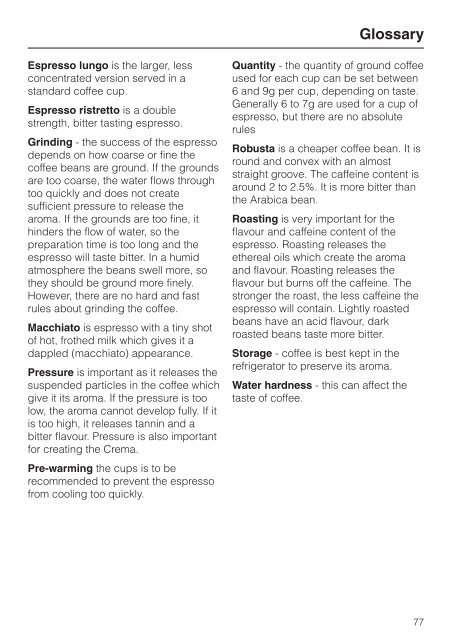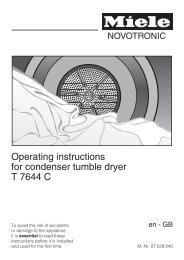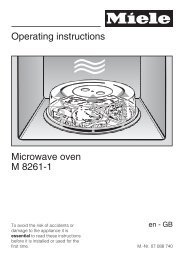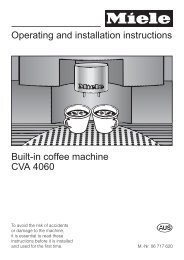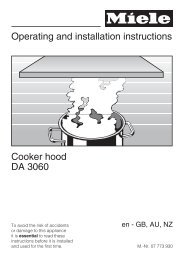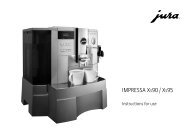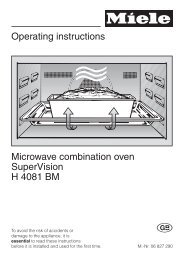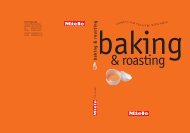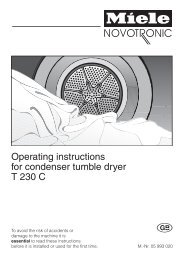Operating instructions Built-in automatic coffee machine CVA ... - Miele
Operating instructions Built-in automatic coffee machine CVA ... - Miele
Operating instructions Built-in automatic coffee machine CVA ... - Miele
Create successful ePaper yourself
Turn your PDF publications into a flip-book with our unique Google optimized e-Paper software.
Glossary<br />
Espresso lungo is the larger, less<br />
concentrated version served <strong>in</strong> a<br />
standard <strong>coffee</strong> cup.<br />
Espresso ristretto is a double<br />
strength, bitter tast<strong>in</strong>g espresso.<br />
Gr<strong>in</strong>d<strong>in</strong>g - the success of the espresso<br />
depends on how coarse or f<strong>in</strong>e the<br />
<strong>coffee</strong> beans are ground. If the grounds<br />
are too coarse, the water flows through<br />
too quickly and does not create<br />
sufficient pressure to release the<br />
aroma. If the grounds are too f<strong>in</strong>e, it<br />
h<strong>in</strong>ders the flow of water, so the<br />
preparation time is too long and the<br />
espresso will taste bitter. In a humid<br />
atmosphere the beans swell more, so<br />
they should be ground more f<strong>in</strong>ely.<br />
However, there are no hard and fast<br />
rules about gr<strong>in</strong>d<strong>in</strong>g the <strong>coffee</strong>.<br />
Macchiato is espresso with a t<strong>in</strong>y shot<br />
of hot, frothed milk which gives it a<br />
dappled (macchiato) appearance.<br />
Pressure is important as it releases the<br />
suspended particles <strong>in</strong> the <strong>coffee</strong> which<br />
give it its aroma. If the pressure is too<br />
low, the aroma cannot develop fully. If it<br />
is too high, it releases tann<strong>in</strong> and a<br />
bitter flavour. Pressure is also important<br />
for creat<strong>in</strong>g the Crema.<br />
Pre-warm<strong>in</strong>g the cups is to be<br />
recommended to prevent the espresso<br />
from cool<strong>in</strong>g too quickly.<br />
Quantity - the quantity of ground <strong>coffee</strong><br />
used for each cup can be set between<br />
6 and 9g per cup, depend<strong>in</strong>g on taste.<br />
Generally 6 to 7g are used for a cup of<br />
espresso, but there are no absolute<br />
rules<br />
Robusta is a cheaper <strong>coffee</strong> bean. It is<br />
round and convex with an almost<br />
straight groove. The caffe<strong>in</strong>e content is<br />
around 2 to 2.5%. It is more bitter than<br />
the Arabica bean.<br />
Roast<strong>in</strong>g is very important for the<br />
flavour and caffe<strong>in</strong>e content of the<br />
espresso. Roast<strong>in</strong>g releases the<br />
ethereal oils which create the aroma<br />
and flavour. Roast<strong>in</strong>g releases the<br />
flavour but burns off the caffe<strong>in</strong>e. The<br />
stronger the roast, the less caffe<strong>in</strong>e the<br />
espresso will conta<strong>in</strong>. Lightly roasted<br />
beans have an acid flavour, dark<br />
roasted beans taste more bitter.<br />
Storage - <strong>coffee</strong> is best kept <strong>in</strong> the<br />
refrigerator to preserve its aroma.<br />
Water hardness - this can affect the<br />
taste of <strong>coffee</strong>.<br />
77


